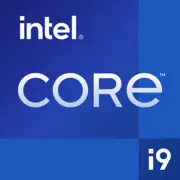Intel Core i9-12900

Intel Core i9-12900: Comprehensive Review of the 2025 Processor
(Relevant as of March 2025)
1. Key Specifications: Architecture, Process Technology, and Key Features
The Intel Core i9-12900 processor, released in late 2021, remains relevant in 2025 due to its unique hybrid architecture called Alder Lake. It was the first mass-market Intel CPU to combine Performance-cores (P-cores) and Efficient-cores (E-cores).
- Process Technology and Structure:
The chip is manufactured using the Intel 7 process (equivalent to 10nm Enhanced SuperFin). It consists of 16 cores: 8 high-performance P-cores (with Hyper-Threading, totaling 16 threads) and 8 energy-efficient E-cores (8 threads). In total, there are 24 threads.
- Frequencies and Cache:
The base frequency of the P-cores is 2.4 GHz, but they can boost up to 5.0 GHz in Turbo Boost mode. The L3 cache is 30 MB, which accelerates the processing of complex tasks.
- Power Consumption:
The TDP is 65 W, but under load, real consumption can reach 150-180 W (depending on PL1/PL2 settings).
- Graphics:
The integrated UHD Graphics 770 solution supports 4K/60Hz and basic gaming (e.g., CS:2 at low settings).
Key Features:
- Support for PCIe 5.0 (up to 16 lanes) and DDR5.
- Thread Director technology for optimizing task distribution among cores (requires Windows 11).
- Capability to work with DDR4—this reduces the overall build cost.
2. Compatible Motherboards: Sockets and Chipsets
The processor uses the LGA 1700 socket, compatible with the 600 and 700 series chipsets (Z690, H670, B660, H610).
- Z690/Z790:
The best choice for enthusiasts. Supports overclocking, PCIe 5.0 x16, and multiple M.2 slots (e.g., ASUS ROG Strix Z790-F Gaming—$320).
- B660/B760:
Ideal for most users. No CPU overclocking, but supports PCIe 4.0 and DDR5/DDR4 (MSI MAG B760 Tomahawk—$180).
- H610:
A budget option for office PCs. Only DDR4, with a limited number of ports (Gigabyte H610M S2H—$90).
Tip: If you plan to use DDR4, choose motherboards that support XMP profiles for stable operation at high frequencies.
3. Memory Support: DDR4 vs DDR5
The Intel Core i9-12900 works with both types of memory but with some nuances:
- DDR5:
By 2025, the prices of DDR5 have equaled those of DDR4. Modules rated at 5600-6000 MHz are recommended (32 GB Kit—$120-150). Benefits include high bandwidth for rendering and data compression.
- DDR4:
Cheaper but limited to frequencies of 3200-3600 MHz (32 GB Kit—$80-100). Suitable for gaming and everyday tasks.
Practical Example: In tests of Cyberpunk 2077, the difference between DDR4 and DDR5 was only 5-7 FPS, but in Adobe Premiere Pro, rendering with DDR5 was accelerated by 15%.
4. Power Supply Units: Power Recommendations
The official TDP of 65 W is just a baseline indicator. Under load (e.g., in Blender), the processor can consume up to 180 W.
- With a discrete graphics card (NVIDIA RTX 4070 Ti / AMD RX 7900 XT):
A minimum of 750 W is required (Gold or Platinum certification recommended). Example: Corsair RM750x (2025)—$130.
- Without discrete graphics:
500-600 W is sufficient (e.g., be quiet! Pure Power 12 M 600W—$90).
Important: Cheap PSUs may not handle peak loads, causing throttling.
5. Pros and Cons of the Intel Core i9-12900
Pros:
- High performance in single-threaded tasks (Geekbench 6 Single-Core—2470).
- Energy efficiency at idle due to E-cores.
- Support for DDR4/DDR5 and PCIe 5.0.
Cons:
- Requires an expensive cooling solution for Turbo Boost.
- Cannot overclock the CPU on B660/H610 chipsets.
- In 2025, competitors offer more cores at the same price (e.g., AMD Ryzen 9 7900).
6. Usage Scenarios
- Gaming:
The processor handles any games at 4K (with a powerful GPU). In Alan Wake 2 (2025), FPS is on par with Ryzen 7 7800X3D.
- Work Tasks:
Video editing (Premiere Pro), 3D rendering (Blender), programming. Multi-Core Score Geekbench 6—13001, surpassing Ryzen 9 5900X.
- Multimedia:
Stream + play without lag, thanks to 24 threads.
7. Comparison with Competitors
- AMD Ryzen 9 7900 ($400):
12 Zen 4 cores, TDP 105 W. Better in multi-threaded tasks but weaker in single-threaded (Geekbench 6 SC—2300).
- Apple M2 Ultra (for Mac mini—$3000):
Higher energy efficiency but limited compatibility with Windows software.
- Intel Core i7-13700K ($380):
A lower model from 2023. Lags in multi-threading but is cheaper.
8. Practical Assembly Tips
- Cooling:
Choose an AIO (e.g., NZXT Kraken X63—$150) or a top-tier air cooler (Noctua NH-D15—$110).
- Case:
Ensure good ventilation. At least 3 case fans (Lian Li Lancool III—$140).
- BIOS Update:
For compatibility with new 700-series chipsets.
9. Final Conclusion: Who Should Choose the Core i9-12900?
This processor is ideal for:
1. Gamers wanting maximum FPS at 4K.
2. Professionals working with heavy software (editing, 3D).
3. Enthusiasts who value a balance of price and performance.
As of 2025, the i9-12900 can be purchased for $350-400 (new), making it a worthwhile alternative to newer models. Its main advantage is versatility—it handles both gaming and work tasks well, and support for DDR4 reduces the cost of the build.
Basic
CPU Specifications
Memory Specifications
GPU Specifications
Miscellaneous
Benchmarks
Compared to Other CPU
Share in social media
Or Link To Us
<a href="https://cputronic.com/en/cpu/intel-core-i9-12900" target="_blank">Intel Core i9-12900</a>